
In 2019, Philips introduced a new product line called ExpertClean, and it’s aimed at a similar section of the market as the ProtectiveClean range that came before it. They’re both positioned to sit somewhere in the middle of the market—neither cheap nor high-end—so we’re taking a look at the ExpertClean 7300, the 7500 and the ProtectiveClean 6100, in a side-by-side comparison. We will delve into what they have to offer to help you decide which one will suit you best.
Note that currently the ExpertClean 7300 (HX9610) is only available on the Philips official website and BestBuy, while on Amazon, you can only find the ExpertClean 7500 (HX9690)! Maybe this is so-called “channel differentiation strategy”.
Side-by-Side Comparison
Appearance and Color Options
So, as you can see, with these three there’s a price difference to think about, and the ExpertClean 7500 is pushing the boundaries of what ‘middle of the market’ means. It’s edging towards the upper end at that price.
For the money, you get a choice of black, white or pink, all of which look nice. The black has a sort of dull finish which looks more high-end than a shiny finish would, the white has nice silver accents and the pink has a rich luster.
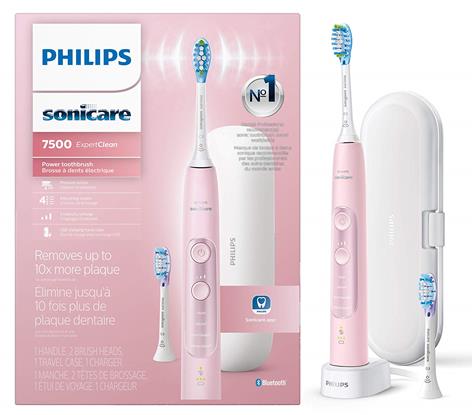
The ExpertClean 7300 looks the same and comes in black and white-silver, and with the ProtectiveClean 6100 you get a choice of navy blue, deep purple, pink and white. In typical Phillips fashion, all these handles look sleek and attractive and build quality looks excellent.
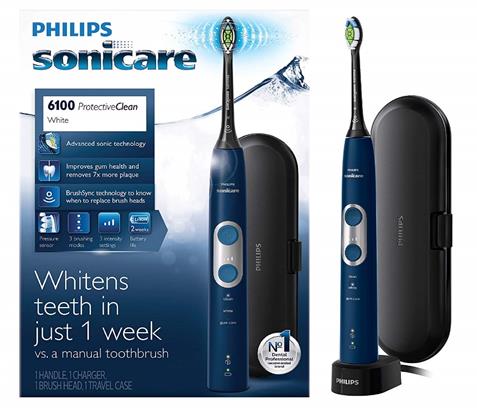
Cleaning Modes
The ExpertClean 7500 offers 4 brushing modes which seems to have more choices than the previous generation – ProtectiveClean 6100.
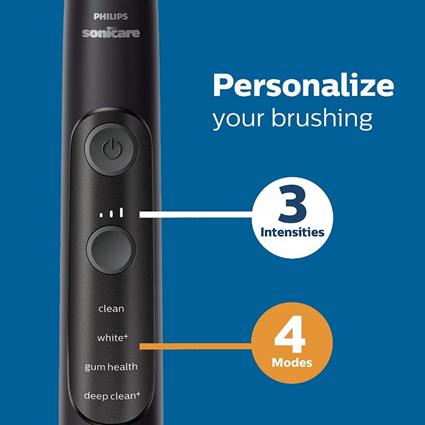
You’ll notice from above table that some of the brushing modes are labeled with a plus (+) sign, but they’re actually have the similar benefits comparing with similar modes on ProtectiveClean 6100. That’s also true of Gum Health and Gum Care, which are also different labels for the same feature.
- Clean is the everyday standard mode for daily tooth cleaning. It lasts for 2 minutes and is ideal for most users to brush with on a daily basis.
- White/White+ mode lasts for 2 minutes and 40 seconds.After the first 2 minutes, the brush speed switches up to high power, which you are supposed to use to polish the top and bottom teeth for 20 seconds each. You can tell when it changes because it sounds different. The extra time spent brushing should help to remove any surface stains and increase surface shine. Once again, even though there’s + sign for one of them, these modes do exactly the same thing.
- Deep Clean/Deep clean+ mode lasts for up to 3 minutes. If the brush handle has Bluetooth capability and is connected to your smartphone it will last for just 2 minutes. If there is no active Bluetooth connection, it will run for 3 minutes. The motion and speed changes to massage the teeth and gums to really give stains and bacteria a hard time. It feels reassuring to spend the extra time doing this.
- Gum health/Gum Care runs for 2 minutes in the standard clean mode, then for another minute at a slower speed, so you can massage and stimulate your gums to boost their health. It’s meant to increase blood flow which promotes healing, so if your gum health has been suffering lately then this may be just what you need.
Brushing Speed
“The only true sonic technology” is how Philips describes the action of their brushes. All three of them use high-speed vibrations to produce up to 31,000 brush strokes per minute. This whips up your toothpaste into a froth which is said to penetrate deeper between the teeth and along the gum line for better cleaning.
You may also see a figure of 62,000 movements per minute quoted here and there, and that’s because Philips sometimes counts both the back and forth of a brushstroke and adds them together. Either way, there’s a lot of movement going on. It isn’t at this level all the time because the speed is slower for some cleaning modes, like Gum Care, but at full speed, it feels very ‘buzzy’ on your teeth and you can really feel it clean.
Cleaning performance and benefits
The sheer amount of movement that the brush heads on all of these toothbrushes can produce is immense. The descriptions on the Philips website for both the ExpertClean 7300 and the 7500 say that they can remove up to 10 times more plaque than a manual toothbrush and achieve up to 7 times healthier gums in just two weeks.
It’s hard to test these kinds of claims for yourself but suffice to say that it certainly feels as if they are true. The language Philips uses for the ProtectiveClean 6100 has a slightly different emphasis— “Whiter teeth. Gently does it.” It claims to whiten teeth in a week by removing surface stains while still being good at brushing sensitive areas, orthodontics, and dental work.
Major functions
All three brushes have three intensity settings, low medium and high. Each model features a Smartimer to encourage a full two minutes’ brushing, as recommended by dental professionals.
The ProtectiveClean 6100 has the Philips QuadPacer feature which alerts you every 15 seconds to brush a different quarter of your mouth. The other two also have a BrushPacer feature but you can’t really call it “Quad” because it divides the mouth into six instead of four, so you get:
- 1 – Upper right back teeth
- 2 – Upper front teeth
- 3 – Upper left back teeth
- 4 – Lower left back teeth
- 5 – Lower front teeth
- 6 – Lower right back teeth
This may look a bit complicated, but I soon got used to it.
All three brushes also have brush head recognition, so the handle knows which brush head you attached to it, and it sets the right mode and intensity for the best possible clean.
And all the brushes also share built-in pressure sensors to ensure that you don’t press on too hard. Get a bit too angry with your teeth and the toothbrush makes a pulsing sound to tell you to back off. Over-brushing can cause gum pain, so this is a very useful feature.
But even if you’ve been gentle, your brush heads will eventually need replacing due to wear and tear, so the BrushSync replacement reminder feature is very useful. A light on the handle and a short beep let you know when it’s time to change.
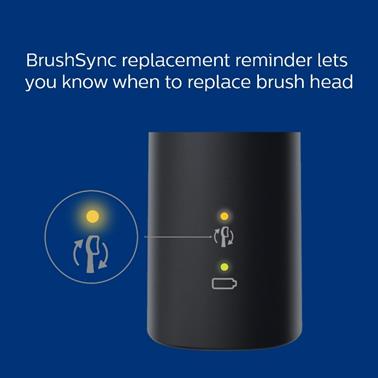
Bluetooth & App
The ProtectiveClean 6100 doesn’t have Bluetooth connectivity while the ExpertClean 7300 and 7500 do, but they don’t report about your brushing in real-time, as more expensive models do, just afterward. They log brushing data over the previous seven days and send it to the app on your smartphone for you to review.
Battery performance and charging system
All models feature a long-life battery that lasts for a claimed 14 days, based on two sessions of brushing for two minutes each. But I have to say that in my experience they will go on for longer than this, which is impressive considering that some of the brush modes can last three minutes!
The ExpertClean 7500 comes with a charger and a travel case that can replenish the handle via USB, whereas the other two just have a regular charging platform. A full charge takes about 12 hours.
Comments of Three Midmarket Sonicare Electric Toothbrushes
Sonicare ExpertClean 7300/7500
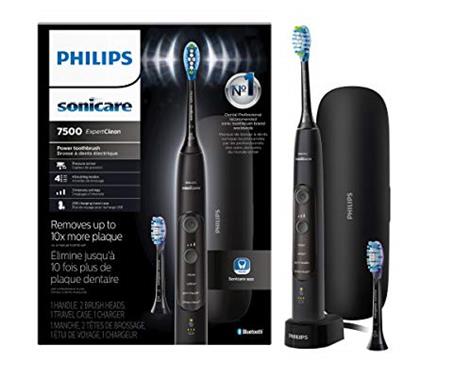
What’s in the Box?
- ExpertClean 7300/7500 Handle X 1
- Premium Plaque Control X1
- Premium Gum Care X 1
- Standard Travel Case X 1 (For 7300 only)
- Smart Travel Case with USB Port X 1 (For 7500 only)
- Base Charger X 1
Both of these two new models are really good at cleaning your teeth. They tell you if you’re brushing too hard, when to change brush heads, they pair automatically with those heads, and they guide you on how long to spend brushing in each part of your mouth.
If there’s one criticism I could level at all in these brushes, then it’s the speed that the heads move at. They really are very fast which might put some people off if they aren’t used to them. But then, Phillips probably included the easy-start feature for just that reason. Over 14 days it gradually increases brush speed and you get used to it.
I could also mention the size of the heads, which are a lot bigger than those offered by Oral-B, so if you have a small mouth you may struggle to fit their heads into the space between your molars and your cheeks.
Other features of ExpertClean 7300/7500:
- Shipping Dimension: 6.8w x 3.1d x 9.4h (inches)
- Unit Weight: 1.08 pounds
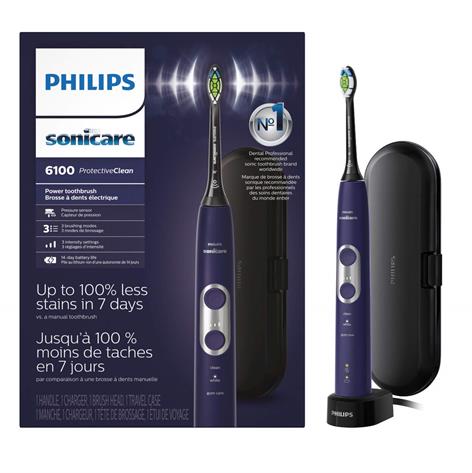
Sonicare ProtectiveClean 6100 (HX)
What’s in the Box?
- ProtectiveClean 6100 X 1
- DiamondClean Brush head X 1
- Standard Travel Case X 1
- Base Charger X 1
The ProtectiveClean 6100 is also very good, to the point where it’s difficult to tell the difference between it and the other brushes. Everyday brushing is a pleasure, and it always leaves my mouth feeling extremely clean and fresh. Basically, it’s a great toothbrush that gives you the kind of cleaning that you’d want. It doesn’t give you the feedback that you’d get with a smartphone app, but if you just want super-clean teeth, then it won’t let you down.
Other features of ProtectiveClean 6100:
- Shipping Dimension: 6.8w x 2.6d x 9.3h (inches)
- Unit Weight: 1.0 pounds
For more specifications, please see our comprehensive analysis of:
Conclusion
These are three great toothbrushes that do virtually the same thing in terms of brushing. I’m not particularly interested in the smartphone app, so my personal choice would be the 6100, and even if you are interested in Bluetooth features, I’d still advise you to buy the 6100. You don’t get the full experience of real-time brushing advice with the 7300 and the 7500, so why pay more for only half a feature?
